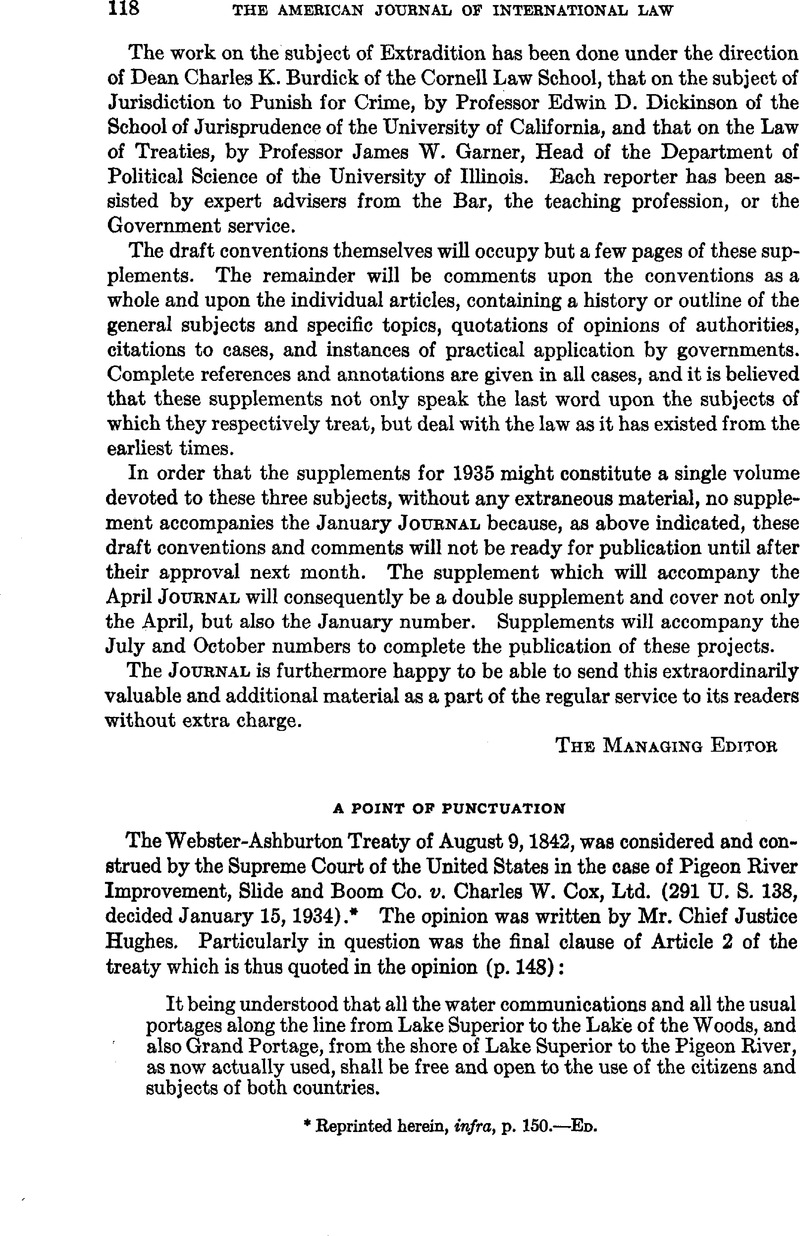No CrossRef data available.
Article contents
Abstract

- Type
- Current Notes
- Information
- Copyright
- Copyright © American Society of International Law 1935
References
* Reprinted herein, infra, p. 150.—ED.
1 One of them differs slightly in capitalization; but variances of capitalization are not herein discussed or even noted. Curiously enough, however, in this very case, in the brief of counsel for the appellant, the suggestion is made that the words “the cascades “ in the Act of March 3,1901,31 Statutes at Large, 1455, refer to “a number of such falls” of Pigeon River and not merely to the one called “The Cascades.“
2 The following is from the opinion in the case of Ewing v.Burnet, 11 Peters, 41, at p.54: “Punctuation is a most fallible standard by which to interpret a writing; it may be resorted to when all other means fail; but the Court will first take the instrument by its four corners, in order to ascertain its true meaning: if that is apparent on judicially inspecting the whole, the punctuation will not be suffered to change it.“
3 It is the rule of the treaty edition now under preparation by the Department of State (entitled Treaties and Other International Acts of the United States of America)that the source text of a bilateral treaty is the signed original (or one of the signed originals) thereof which is in the archives of the Department of State; and that rule is strictly followed except in cases where it is either necessary or because of highly unusual circumstances desirable to depart from it. Of that edition, Volumes 1 (short print), 2, and 3 have been published. The text of the Webster-Ashburton Treaty will appear in Volume 4 as Document 99, at page 363 et seq.That volume has reached the stage of plate proof. The text therein printed is, of course, the Otext.
4 There are early instances of multipartite bilateral treaties; the Treaty of Ghent, for example, was signed in six original examples, three of which are now in the archives of the Department of State.
5 As printed in the official report cited.
6 The original Senate print of this message and accompanying papers is not now available; it may be, however, that the Senate document of Dec. 7,1842, is from the same type as that print, with changes of page numbers; a Senate resolution of Aug. 30,1842, removed the injunction of secrecy “as soon as” the treaty “shall have been proclaimed“; the date of the proclamation is Nov. 10,1842.
7 The record copy reads thus: “It being understood that all the water communications, and all the usual portages along the line from Lake Superior to the Lake of the Woods, and also Grand Portage, from the shore of Lake Superior to the Lake of the Woods, and also Grand Portage, from the shore of Lake Superior to the Pigeon River, as now actually used, shall be free and open to the use of the subjects and citizens of both countries.“
8 Collated with the S text, it corresponds in the comma after “Lake of the Woods“; but it adds a comma after “communications” and one after “portages“; and it omits the comma after “Grand Portage.“
9 It reads as follows: “All the water communications, and all the usual portages along the line from Lake Superior to the Lake of the Woods, and also Grand Portage, from the shore of Lake Superior to the Pigeon River, as now actually used, to be free and open to the use of the subjects and citizens of both countries.“




